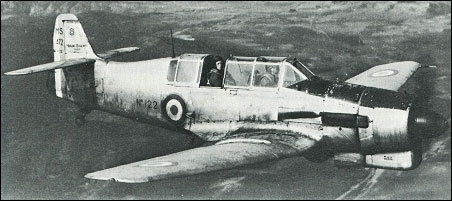 |
Morane-Saulnier M.S.470 Vanneau1944 |  |
| BASIC TRAINER | Virtual Aircraft Museum / France / Morane-Saulnier |
 |
Developed under the Vichy regime by Morane-Saulnier chief designer Gauthier, the Morane-Saulnier M.S.470.01 Vanneau two-seat advanced trainer prototype made its first flight on 22 December 1944. Successful tests led to a decision by the Armee de I'Air to buy the Vanneau (plover) to train its new generation of pilots, and three prototypes of the revised M.S.472 were ordered, M.S.372.01 flying on 12 December 1945. In configuration the M.S.470 was an all-metal low-wing cantilever monoplane with pupil and instructor housed under a long glazed canopy. The main landing gear legs retracted inwards to lie partially exposed in the fuselage underside, a feature which was intended to reduce damage in the event of 'wheels-up' landings. The M.S.472 replaced the 515kW Hispano-Suiza 12X engine of the M.S.470 with a 522kW Gnome-Rhone 14M radial. Series M.S.472s were delivered from December 1946 onwards, and series M.S.474 aircraft, modified for carrier operations, were delivered to the Aeronavale from December 1947, an M.S.472 having been temporarily converted to serve as the prototype M.S.474 in February of that year. Total production of the M.S.472 Vanneau II was 230 and of the M.S.474 Vanneau IV 70. Another series version was the M.S.475 Vanneau V, the prototype making its maiden flight on 8 August 1947. Production deliveries of the 200 series aircraft to the Armee de I'Air began in March 1950, the M.S.475 differed only in detail from its predecessors except for installation of a 634kW Hispano-Suiza 12Y-45 V-12 engine. The M.S.475 proved superior to its predecessors in manoeuvrability, speed and rate of turn, incorporating a wing of improved design, but a more radical modification with an increase in wing surface area was incorporated in one production machine, which was then re-designated M.S.476.01. Another M.S.475 was re-engined with an SNECMA Renault 12S-02 of 433kW and became the M.S.477.01, flown in November 1950. The M.S.478.01 project, to be powered by an Italian Isotta Fraschini Delta engine, was not built, and the last experimental development of the Vanneau was M.S.472 no. 295 modified as the M.S.479.01 to take an SNECMA 14X Super Mars engine of 611kW. It began its flight test programme in March 1952, but development was soon abandoned. The Vanneau II, IV and V remained in service at training bases of the Armee de I'Air and Aeronavale into the late 1960s.
|  COMPANY PROFILE | |||||||||||||||||||||||||||||||||||||||||||||||||||||
 |

|
